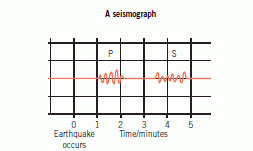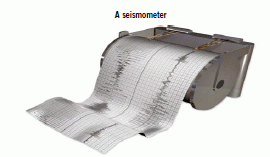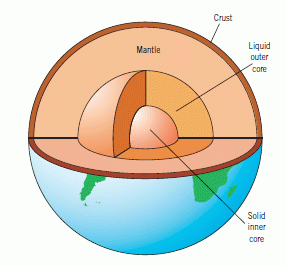Seismic Waves and the Earth
Seismic Waves
Seismic waves are caused by earthquakes or large explosions, such as quarrying operations or atomic bomb tests. P-waves and S-waves both travel through the Earth and are detected at monitoring stations all around the Earth by instruments called seismometers. They record the waves arriving on a seismograph.
P-waves travel faster through the Earth than other seismic waves, so they are the first to be detected after an earthquake. They are primary waves and are longitudinal.
S-waves are detected after primary waves.

The time delay between the arrival of the P-wave and S-waves is greater at stations further from the earthquake, so the distance to the earthquake centre can be calculated. Using information from several stations the position of the earthquake is worked out.
The structure of the Earth’s crust is investigated by setting up monitoring equipment at different points and setting off a controlled explosion. The waves are then recorded arriving at the monitoring points. Analysing this data gives information about the rock structure.

The Structure of the Earth
The Earth is made up of a core, a mantle and a crust. The theory of continental drift was first suggested by Alfred Wegener in 1912, based on the way the continents appeared to fit together like a jigsaw, and matching fossils and rock layers on different continents. Due to lack of evidence, it was not until 1967 that the theory of plate tectonics was accepted.
The Earth’s crust consists of a number of moving sections called tectonic plates. The mantle behaves like a very thick liquid. The plates move because of convection currents in the mantle.

The Rock Cycle
Magma flows out of the mid-ocean ridges forming new rock, so the sea floor spreads by a few centimetres a year and this causes the continents to move apart.
At boundaries, where two plates collide, rocks are pushed up forming new mountain ranges or when plates slide past each other this can sometimes cause earthquakes.
At boundaries where magma comes to the surface there are volcanoes.
This is why earthquakes, mountains and volcanoes are generally found along the edges of the tectonic plates.
